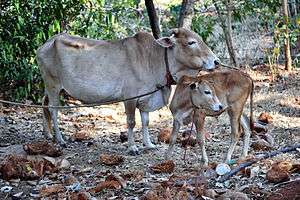Vechur Cattle
The Vechur Cattle (Malayalam: വെച്ചൂര് പശു) is a rare breed of Bos indicus cattle named after the village Vechoor in Vaikom Taluk, Kottayam district of the state of Kerala in India. With an average length of 124 cm and height of 87 cm, it is the smallest cattle breed in the world according to the Guinness Book of Records,[1] and is valued for the larger amount of milk it produces relative to the amount of food it requires.[2] The Vechur animals were saved from extinction due to conservation efforts by Sosamma Iype, a Professor of Animal breeding and Genetics along with a team of her students.[3] In 1989, a conservation unit was started. A Conservation trust was formed in 1998 to continue the work with farmer participation.[4]

The Vechur cow was popular in Kerala until the 1960s, but became rare when native cattle were crossbred with exotic varieties.[5] In 2000, the Vechur cow was listed on the FAO's World Watch List of Domestic Animal Diversity, in its ‘Critical-Maintained Breeds List', pointing to imminent extinction as breeds are included in the list when the number of breeding females and males fall to very low levels.[6] About 200 cows are supposed to exist today, nearly 100 of them with the Veterinary College.
Characteristics
The breed averages about 90 cm in height and weighs around 130 kg, yielding up to 3 litres of milk a day. This is much less than that of the hybrid varieties but, unlike them, the Vechur cow also requires little by way of feed or maintenance.[6] The milk is believed to have medicinal qualities and easy digestibility due to smaller fat globule size.[7] A recent report claims that the milk of the Vechur cow has more of the beta casein variety A2, rather than the variety A1 which is implicated in conditions like diabetes, ischaemic heart disease and autism.[8][9]
The medicinal property of the Vechur cow's milk have been documented traditionally by Ayurveda and recent scientific studies have substantiated this. The protein component of the Vechur cow's milk has an improved antimicrobial property.[10][11] As per recent findings, the anti-bacterial property of the lactoferrin protein present in the Vechur Cow milk is more than that of the antibiotic ampicillin. Although lactoferrin, present in the milk of all mammals, is found to have antimicrobial, antiviral, antitumor, immunodefence and anti-inflammatory properties recent studies prove that in the case of the lactoferrin protein in the Vechur Cow milk, these properties are much more enhanced.[12] The Vechur Ghee (clarified butter) produced from Vechur cow’s milk, is famous for its high medicinal values due to the presence of A2 beta-lactalbumin protein and higher arginine content which is good for the health of convalescing people.[13]
Controversies
A controversy arose in 1997 when environmentalist Vandana Shiva alleged that a Scottish company, The Roslin Institute was trying to patent the cow's genetic code. Shiva described the action as piracy. The Roslin Institute denied the charge which was subsequently proved to be baseless.[2][14][15]
References
- "Shortest cow (height)". Guinness World Records. Retrieved 21 June 2014.
- Krishnakumar, R. (9 April 1999). "A cow and controversy", Frontline.
- Animal genetics Resource Bulletin 1997 (FAO)
- Proceedings of the National Conference on Native Livestock Breeds and their Sustainable Use 2010.
- Prabu, M. J. (1 December 2005). "Vechur cattle: ideal for household rearing". The Hindu. Retrieved 6 January 2012.
- Sainath, P. (5 January 2012). "Holy cow! Small is beautiful". The Hindu.
- Thirpathy and Iype 1997 www.vechur.org
- "Beta casein A1 and A2 in milk and human health", Report to New Zealand Food Safety Authority, http://www.nzfsa.govt.nz/policy-law/projects/a1-a2-milk/a1-a2-report.pdf
- Nair, Madhavan (31 July 2010). "Milk of the indigenous Vechur cow beneficial to health". The Hindu. Retrieved 6 January 2012.
- http://www.thehindu.com/todays-paper/tp-national/study-points-to-medicinal-value-of-vechur-cow-milk/article2784409.ece
- Shashidharan, A; Singh, R; Bhasker, S; Mohankumar, C (2011). "Physicochemical characterization and functional site analysis of lactoferrin gene of Vechur cow". Bioinformation. 6: 275–8. doi:10.6026/97320630006275. PMC 3124693. PMID 21738329.
- http://ibnlive.in.com/news/medicinal-property-of-vechur-cow-milk-confirmed/218005-60-122.html
- http://www.newindianexpress.com/states/kerala/After-Neera-Here%E2%80%99s-Another-Healthy-Drink---Packaged-Vechur-Cow-Urine/2014/10/24/article2490838.ece
- Jose, D. (12 August 1999). "Mystery shrouds Vechoor cow patent issue", Rediff.com.
- Hall, Stephen J. G. (2008). Livestock Biodiversity. Blackwell Publishing. p. 178. ISBN 0-632-05499-9.
- Beta Casein A1a2 Polymorphism And Milk Yield In Vechur, Kasargode Dwarf And Crossbred Cattle Author : E. M. Muhammed and M. Stephen